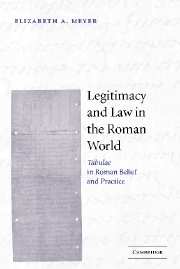Book contents
- Frontmatter
- Contents
- List of illustrations
- Acknowledgments
- List of abbreviations
- Introduction
- Part One THE WORLD OF BELIEF
- Part Two THE EVOLUTION OF PRACTICE
- Chapter 6 Roman tablets in Italy (AD 15–79)
- Chapter 7 Roman tablets and related forms in the Roman provinces (30 BC–AD 260)
- Chapter 8 Tablets and other documents in court to AD 400
- Chapter 9 Documents, jurists, the emperor, and the law (AD 200–AD 535)
- Conclusion
- References
- Index
Chapter 7 - Roman tablets and related forms in the Roman provinces (30 BC–AD 260)
Published online by Cambridge University Press: 22 September 2009
- Frontmatter
- Contents
- List of illustrations
- Acknowledgments
- List of abbreviations
- Introduction
- Part One THE WORLD OF BELIEF
- Part Two THE EVOLUTION OF PRACTICE
- Chapter 6 Roman tablets in Italy (AD 15–79)
- Chapter 7 Roman tablets and related forms in the Roman provinces (30 BC–AD 260)
- Chapter 8 Tablets and other documents in court to AD 400
- Chapter 9 Documents, jurists, the emperor, and the law (AD 200–AD 535)
- Conclusion
- References
- Index
Summary
Tabulae changed over time. Roman-law documents from the Roman provinces demonstrate close connections to Roman practice as it had developed in Italy in the first century AD, and through these connections, by the impact these documents have, and by the changes these documents themselves underwent, help to illuminate an administrative and legal dynamic in the complicated process of cultural change that characterized the first two-and-a-half centuries of the Roman empire. On these tabulae, and the behaviors and beliefs associated with them, there is perceptible influence from the center – not through laws or senatusconsulta, as had been the case with wills, but through authoritative example and Roman decisions taken for Roman reasons. This points to a mechanism of cultural change that is above all a mediated one, one in which – no matter what local practice a change may seem to mimic – the figure of the local Roman official or the distant emperor is the most important one, even as fides and formality continue to interleave and layer on the wood document. Social and legal hierarchies and the influence of their practices at the near-center, Campania, were visible but subtle and complicated, like a list of sealers from Pompeii; in the provinces, however, they are cruder and more obvious, and what appeared as smooth and subtle incremental evolutions in Roman legal tabulae in Campania as a consequence translate into much more jagged jumps and shifts in more distant parts of the Roman world.
- Type
- Chapter
- Information
- Legitimacy and Law in the Roman WorldTabulae in Roman Belief and Practice, pp. 169 - 215Publisher: Cambridge University PressPrint publication year: 2004

